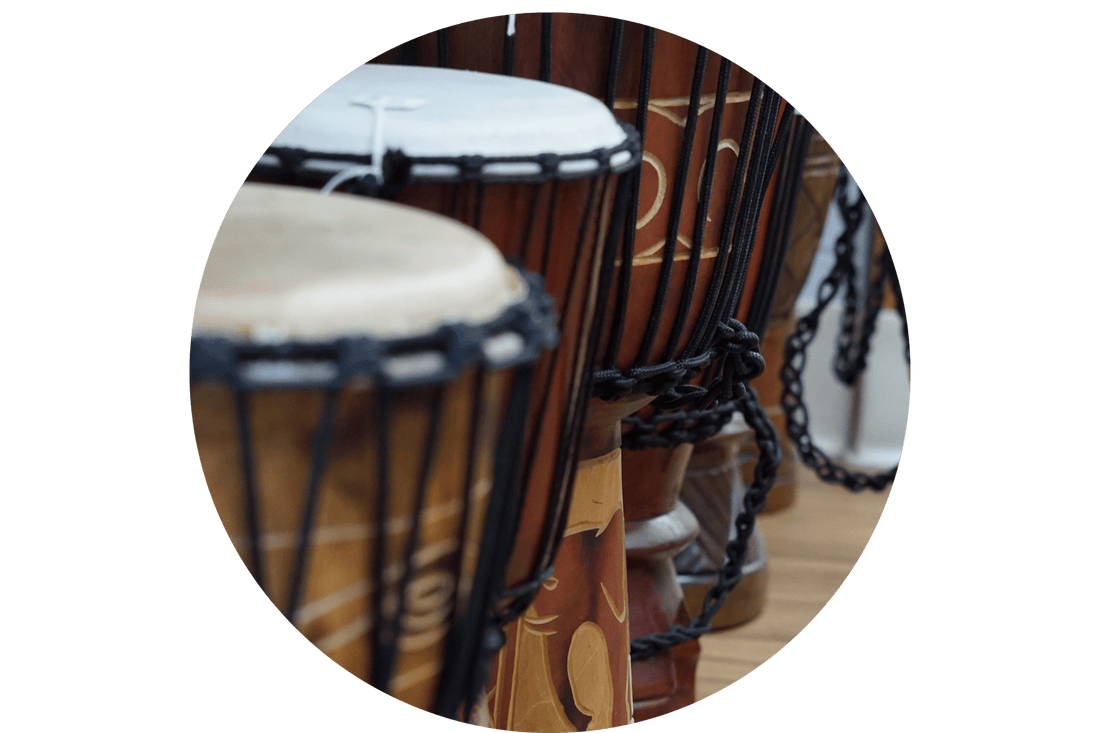
Lors de l’achat d’un djembé , il y a quelques éléments importants à rechercher.
Je possède une entreprise qui fait beaucoup de réparations de djembé. Grâce à un tel volume, nous avons beaucoup appris et J'ai observé que certains conseils douteux étaient donnés aux acheteurs potentiels.
Voici quelques éléments que vous devez garder à l’esprit lors de l’achat d’un djembé.
1. Bord d'appui
ÉVITER : un bord d'appui de moins d'un demi-pouce de hauteur.

Le bord d'appui est le bord supérieur du tambour qui entre en contact direct avec la tête.
Tout bord incurvé et fraisé de moins d'un demi - pouce peut blesser vos mains après une courte période de jeu. Les bords plats peuvent réduire l'intensité sonore.
2. Son vs poids
Examinons maintenant le fût du djembé. En général, les djembés en bois dur comme l'acajou (comme nos djembés de la série Pro ), l'iroko (djembés de Côte d'Ivoire) et le lenké (djembés de Guinée, du Sénégal et du Mali) offrent un son et une projection supérieurs. Cela dit , la qualité sonore est subjective, et j'ai entendu d'excellents djembés en bois tendre du Ghana . tambours. L'un des inconvénients des tambours en bois est leur poids.

Les djembés composites sont beaucoup plus légers, ce qui les rend parfaits pour les enfants et les seniors (de plus, ils sont disponibles dans une variété de couleurs et de motifs !). Cependant, leur projection sonore est moins intense. Cela dit, les conditions météorologiques et la température n'affectent pas leur accordage si le tambour est doté d'une peau en fibre . Ce sont des djembés robustes et pratiques.

Enfin, les djembés composites avec aérations sont parfaits pour un ensemble musical. Légers, ils sont dotés de trous d'aération pour une meilleure projection sans avoir à les soulever du sol. C'est la meilleure option pour les ensembles et les enfants.

3. Qualité de la corde
Une corde de bonne qualité est essentielle. C'est un point sur lequel certains tambours africains sont souvent négligés. La meilleure corde Il est doté d'un noyau qui empêche l'étirement et les réaccordages constants . Le fabricant, qui fabrique la quasi-totalité des tambours indonésiens haut de gamme en Amérique du Nord, utilise une corde d'excellente qualité.

4. Qualité de la tête

Les peaux de chèvre sont généralement préférées aux autres peaux animales. Elles allient parfaitement durabilité et souplesse, avec une épaisseur qui confère au djembé un son authentique.
Les peaux de chèvre africaines de Guinée, du Mali et de Côte d'Ivoire sont généralement plus épaisses et plus résistantes. Les peaux ghanéennes sont souvent plus fines, car elles proviennent de chèvres « pigmées ». Cette petite chèvre est résistante et produit un son grave plus puissant et plus durable . Elles sont idéales pour les tambours à peaux de 11 pouces et moins .
La chèvre d'Amérique du Nord est élastique et , à mon avis , presque inutilisable. Si les peaux sont importées par avion , le certificat vétérinaire n'est pas requis. Il est donc judicieux de se renseigner sur la provenance des peaux ou des fûts.
Les peaux pakistanaises sont généralement plus fines et se cassent plus facilement. Cependant, elles sont moins chères et conviennent parfaitement aux petits tambours.
Le Les meilleures peaux que j'ai utilisées sont celles des djembés indonésiens de la série Pro . Elles sont plus chères . Il existe des peaux indonésiennes moins chères, comparables à celles pakistanaises . Cependant, la différence est immédiatement perceptible au son et à l' aspect usiné . Ces têtes ont été inspectées par un vétérinaire.
Les peaux en Fibreskin sont végétaliennes et utilisées sur nos modèles composites et Air Drum. De haute qualité, incroyablement résistantes, elles produisent un son brillant. Elles sont également moins sujettes aux désaccords dus aux intempéries et aux variations de température. Cependant, elles n'offrent pas la projection recherchée par de nombreux amateurs de djembé authentique. CONSEIL : Appliquez un petit morceau de pâte adhésive à l'intérieur de la peau pour obtenir un son plus sec, semblable à celui d'une peau de chèvre.
REMARQUE : Pour toutes les peaux africaines , vérifiez si elles sont expédiées par avion ou par mer. Les expéditions maritimes nécessitent des inspections vétérinaires pour l'anthrax (les cas d'anthrax sont cependant extrêmement rares ). Les peaux pakistanaises n’ont généralement pas besoin d’être inspectées car elles sont épilées chimiquement.
Peaux poilues ou non poilues ?

J'ai arrêté d'utiliser des peaux à poils à cause de la teigne nord-américaine des aliments. Ces insectes peuvent transformer un beau tambour en Un désastre en quelques semaines. Comme je travaille dans des écoles où l'hygiène et la sécurité sont primordiales, j'évite complètement les cheveux .

5. Réglage de la patte ou de la corde
Les djembés accordés à la corde constituent la méthode traditionnelle d'accordage. Ils sont généralement accordés selon un cordage tressé du Mali . Une fois maîtrisé, l'accordage à la corde devient relativement facile. Les réparations sur les tambours accordés à la corde sont laborieuses et coûteuses. Peu de gens savent comment les réparer.


crédits : https://afrodrumming.com/djembe-tuning/
Les djembés accordés à la clé (ou à la cheville ) sont très faciles à accorder et à réparer : il suffit de serrer les chevilles avec une clé. Leur popularité grandit grâce à leur facilité d'entretien. Cependant, leur prise en main peut parfois être inconfortable si les chevilles sont contre les jambes.


C'est tout pour l'instant ! Si vous pensez que j'ai oublié quelque chose, laissez un commentaire ci-dessous. Qui sait, peut-être que je ferai une deuxième partie… ?
Écrit par Milton Randall, propriétaire d'Empire Music Co.


